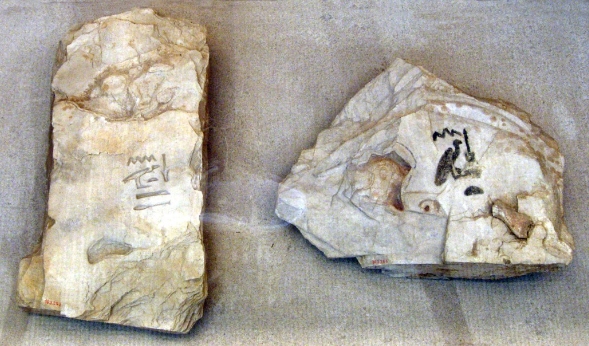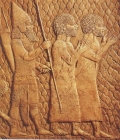(Sen-en-mut – Egyptian, see glyph)
 |
Updated: 2013.10.11
 250x307.jpg) |
Exactly contrary to some superficial, amateur commentators, the translation, "Mother's brother," perfectly corroborates the relationship of the Pharaonic Princess, Isis figure to Sen-en-mut Horus-Moses, the deific Horus-son figure. The weight of evidence increasingly supports my assertion that this Pharaonic Princess adopted into her Pharaonic house, as her brother, the baby she found floating in the reeds of the Nile and named Sen-en-mut Horus-Moses – Horus-incarnate.
In fact, Sen-en-mut can only be identical with Moses: (adopted) brother of Princess Khat-shepset, who was, at the same time, deific mother-Isis to her deific son Horus-Moses!
The historical record of Sen-en-mut's parents demonstrate that Sen-en-mut could only have been his own "mother's brother" if his father had married his aunt – which is exactly the case of Moses!!! As the son of Amᵊram's aunt Yo•khëvꞋëd (Shᵊm•
| Sen-en-mut's Father: |
| Sen-en-mut's Mother: Khat-neferet, Foremost of Beauty |
The similarity between the name of Sen-en-mut's father and Moses' father suggests that the Egyptian name of Sen-en-mut's father is in line with the gâl•Ramose.
The meaning of their names also seem to have a slight correlation; a further similarity to the tradition in the gâl•Ramose means Ra-incarnate, while Amᵊram means "kindred is exalted."
Preservation of the "purity" of the royal Pharaonic blood required meticulous exclusion of breeding with anyone outside of the royal Pharaonic Household. In other words, incest was the rule in the Pharaonic household. Intermarriage with non-royals was prohibited. Even when there was no surviving successor, intermarriage was limited to generals who were next in line to power.
 250x299.jpg) |
Here, it is imperative to interject that "Moses" was raised as a prince, an adoptive brother of Par•Tut-Moses II – who, inexplicably (!), died soon after she married him. This made Moses her perfect match. (Contrasting Sen-en-mut's (Moses'?) mother's features with the Pharaonic family demonstrates that his mother (as well as Par•
No less importantly, the fact that we know Moses only by his Egyptian surname, demonstrates that he (and Yi•sᵊTut. Scholars who associate his name with the Hebrew verb îÈùÑÈä admit that it is of unknown origin. It is crystal clear to anyone not driven by an agenda that this was part of his Egyptian name: ![]()
This also tells us that he had an Egyptian first name that the writers and editors of the Bible refused to note. All of the Egyptian familial evidence, as well as the Scriptural evidence (his deceased, first, "Kushit" (African – Egypt is in Africa) wife (Sen-en-mut, not the deceased Tut-Moses II, was most likely the father of Princess Neferura), bᵊ-Mi•dᵊTut-Moses – and Egyptian General and Chief of Staff, the best-trained military man and national leader in the world, trained from birth by the world's longest-ever enduring superpower.
In this ancient time, infants weren't considered viable by the Hebrews until they reached 30 days old, at which time they were named. It is clear that the infant in the Nile, whom we know today as Moses, had not yet been named when he was placed in the Nile.
Concerning the mother, it must be remembered that Moses' mother, Yo•khëvꞋëd, was brought into the royal Pharaonic Household by Princess Khât-Tut?]-Moses. It might be expected, therefore, that Princess Khât-
Found in the Nile as a baby, by a 12-year old princess of the royal Pharaonic Household (Shᵊm•Horus-Moses of her native religion; the infant god found in the Nile by his mother, the goddess Isis.
Accordingly, this princess identified herself as Isis – mother of her new-found Horus-baby in the Nile (paralleling her own Moses-baby in the Nile).
 |
Then Moses was adopted into the royal Pharaonic household – as her prince-brother – "Mother's brother"! And this happens to be exactly the story of the only mysterious Egyptian Queen-Par•Isis. Even more mysteriously, 20 years after she died, not when she died, her son, having become Par•
Sen-en-mut's tomb is located in Luxor – but he was never buried there!
If Sen-en-mut was Moses, then, in order to shift the blame for the Tut-Moses III had to fabricate a false record of Prince Moses (Sen-en-mut?) as well as Moses's brother, A •ha•
The close correlation between the record of Par•Tut-Moses III's sons and sisters to Sen-en-mut (and, correspondingly, A •ha•
While the chronology cannot be merged, it could easily have been that he felt (and, clearly, we find it so) his expunging of the history of his mother created enough confusion that the names could not be correlated to people with certainty and, therefore, the chronology was irremediably confused as well.
| Son | Son | Son | Son | Daughter | Daughter | |
| Par• | Amun-em-khat | Men-kheper | Sa-i-mn-n | Akh-hotep | Neferet-hor | |
| Amun-em-khat | Minhotep | Perre | Sen-en-mut | - |
Google+ registered author & publisher
Google+



